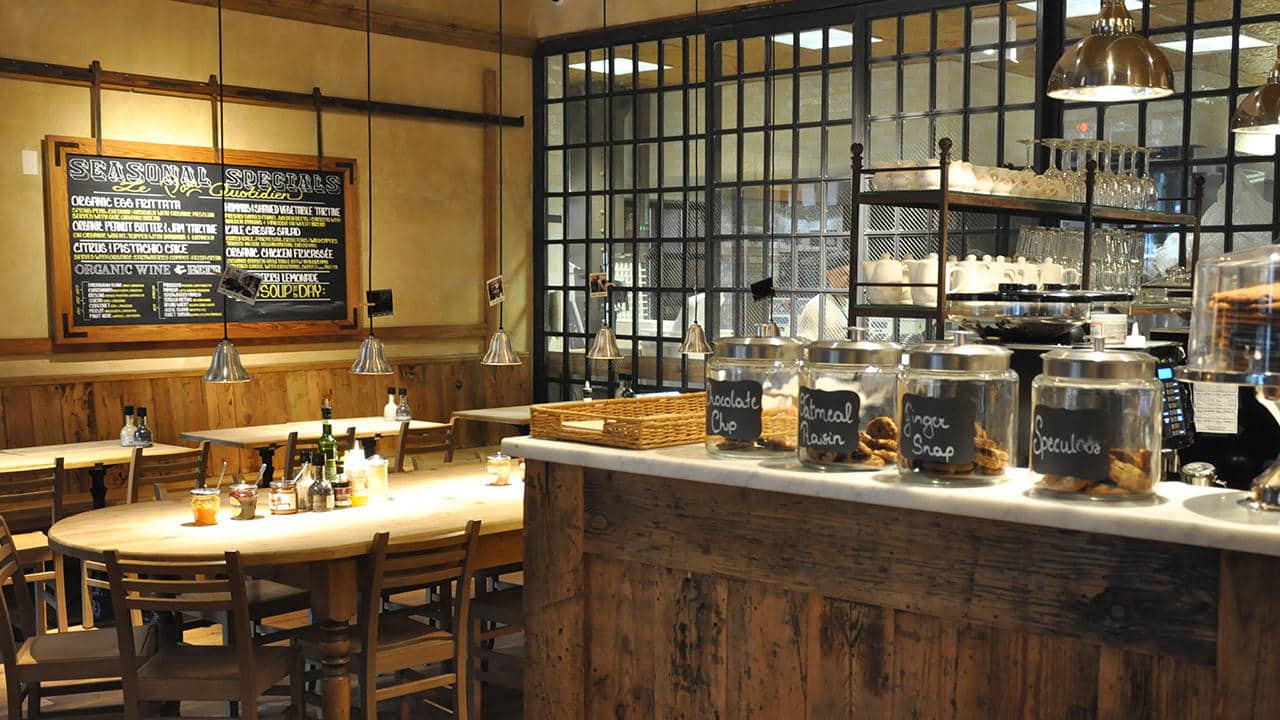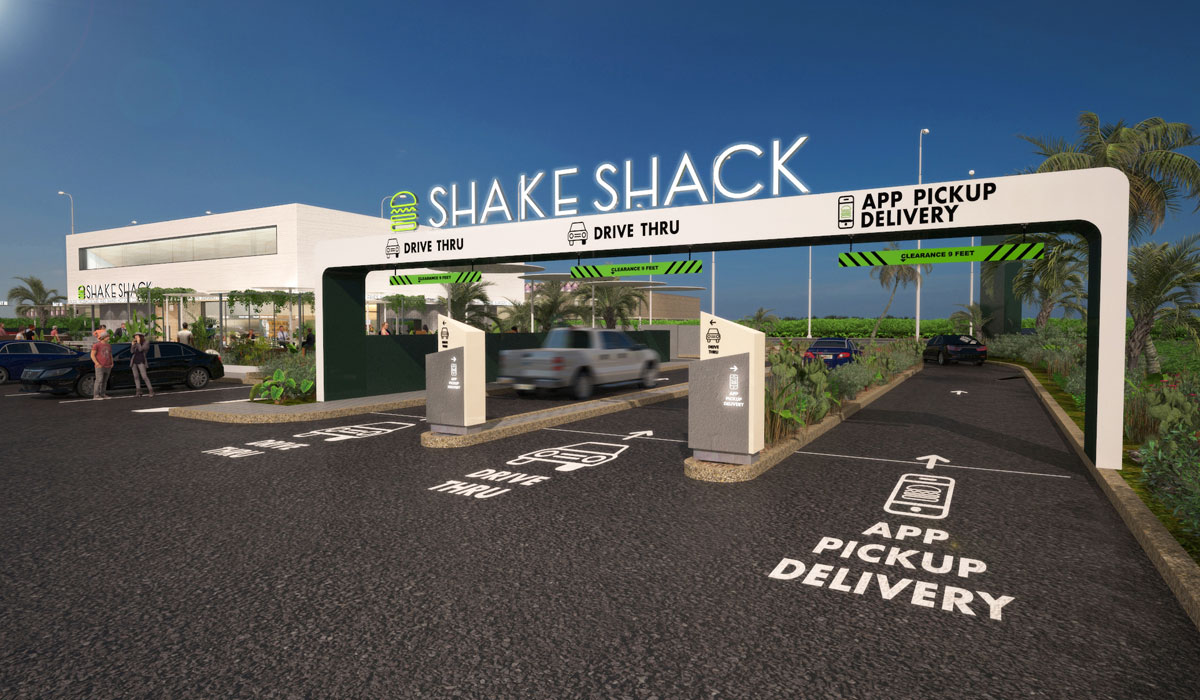As BTIG analyst Peter Saleh put it, Shake Shack is the rare restaurant chain whose brand awareness and recognition exceeds its size and sales base. Simply, it feels a lot bigger than 193 U.S. locations.
And throughout the last few years, this notion was enough to anchor ambitious growth and new-market success. But the landscape is changing fast. In a COVID-19-saddled world, demand doesn’t always translate to sales. There’s a fear factor and erosion in guest willingness to dine out thrown in the mix. Diners might rethink choices for reasons that were hardly deal breakers before. It’s become, in many cases, a points of distribution game. Accessibility as the key to transaction growth.
It’s why Shake Shack is about to reroute its trajectory, and quickly. The fast casual announced Thursday during its Q2 review that it plans to aggressively target a multi-format, diversified portfolio of restaurants that thrive under any circumstance.
This includes Shake Shack’s first drive thru, planned for 2021, in addition to “Shack Tracks,” which are digitally enabled pickup windows. Shake Shack expects to retrofit the latter to at least eight restaurants over the coming months, including a drive-up Shake Track (not a drive thru) in Vernon Hills, Illinois, where guests leave their car. Also, Shake Shack is currently piloting curbside pickup at 10 locations with plans to expand to 50 by the end of Q3.
For 2021, Shake Shack CEO Randy Garutti said, the brand expects roughly half of its new class to feature either a drive-up or walk-up window, with the remaining showcasing a combination of enhanced interior pickup curbside and/or dedicated delivery courier pickup areas.
On the drive-thru debut itself, however, Garutti said it’s not going to be your average fast-food experience. While Shake Shack did not share potential markets yet, it will focus on traditional, suburban high-traffic trade areas.
“Our hope is that we create access in places where we may not have had access before, and we create opportunity in real estate that we may not have had before,” Garutti said.
“Look, in the moment of safety, people want to stay in their cars,” he added. “That’s not going to last forever. But obviously, this country has proven that the drive thru in its old form works. We want to do in this new form. We want to do it better than ever with an experience that you stay in whichever drive-thru you want.”
Below are some renderings, although Garutti cautioned they’re still evolving. The clear goal won’t change, though—accessibility and multiple points of purchase fueled by a digital era.



For curbside pickup, the option allows customers to preorder in Shake Shack’s app and identify their car. An employee then runs the food out with contactless pay and handoff.
In tests to date, Shake Shack climbed from 22 percent of orders to 29 percent in two weeks. While there’s a mix of usage, the company said, some stores are seeing more than 40 percent usage of the curbside option.


During Q2, total digital sales represented 75 percent of Shake Shack’s total take. It more than doubled quarter-to-quarter. Native web and app channels tripled versus 2019. In July, digital sales mixed 62 percent, and, critically, Shake Shack retained 90 percent of digital sales achieved in May, even as in-store sales returned. Additionally, the brand added north of 800,000 first-time purchases via its app and web channels since early March, Garutti said—a figure four times higher than the same period last year.
This success inspired further digital enhancements in the next six to 12 months, including direct delivery through Shake Shack’s app and additional pickup and payment functionality. It’s also working on marketing technology to optimize conversion through stronger segmentation and delivery of more targeted communication to guests. There are no current plans to launch a formal loyalty program.



Back to the asset conversation, Shake Shack’s current footprint is inspiring change as much as the future is. The brand’s Q2 revenue declined 39.9 percent to $91.8 million as same-store sales plummeted 49 percent. Shake Shack posted operating loss of $24.1 million compared to income of $11.9 million in Q2 2019. Net loss was $18 million.
But what needs to be considered is how Shake Shack’s performance unfurled across the map. So far in Q3, same-store sales are down 39 percent. Urban units, however, remain 50 percent lower as they materially underperform suburban markets (negative 24 percent).
It mirrors trends throughout COVID-19. NYC restaurants declined 56 percent in July. Manhattan specifically sank 65 percent. The lag is really tied to Shake Shack’s urban versus suburban breakdown more than anything else.
“There’s no question that hurts us today, and it hurts us more than others that are just drive thru in suburban atmospheres, and you’re seeing that,” Garutti said. “But that will come back … And it’s important for us to continue to build a diverse portfolio that can sustain all of those.”
The following graph, shared in Shake Shack’s earnings presentation, illustrates the disparity.

As the following explains, Shake Shack, given rapid growth in recent calendars, appreciates half of its comp units from urban areas, but 60 percent of base sales pre-COVID-19. For perspective, the brand entered 2020 with 24 percent of its locations 12 months or younger and an average U.S. age of just 2.9 years. Less than 100 units are in Shake Shack’s comps count.

CFO Tara Comonte said the gap in sales performance is something Shake Shack expects to continue as long as COVID-19 impacts cities, offices, travel, recreation, and entertainment habits.
Saleh wrote Friday in a note he expects “anticipate the benefits of many of these initiatives to take several quarters to begin to bear fruit.”
Only half of Shake Shack’s airport units are currently open. Those that are, Garutti said, are operating at “severely reduced sales.” Nearly all of Shake Shack’s domestic stadium venues remain closed. One restaurant—a LAX Airport venue—is not going to reopen as the airport decided to tear down and replace the terminal entirely.
As a whole, about 95 percent of Shake Shack’s corporate stores are open today, an improvement from 90 percent three months ago.
Less than half are operating with interior dining, however, which is actually a reduction compared to a few weeks ago as some previously reopened lobbies had to close again, particularly in high-risk states. Of those operating dine-in business, they’re doing so with limited capacity and leveraging outdoor patio seating where possible.
Shake Shack’s performance at company stores has progressed upward alongside reopenings.
(dollar amounts in thousands and months on fiscal calendar)
Q1
Month ended March 25
- Average weekly sales: $56
- Total year-over-year sales growth: –11 percent
- Same-store sales: –29 percent
Q2
Month ended April 22
- Average weekly sales: $32
- Total year-over-year sales growth: –56 percent
- Same-store sales: –64 percent
Month ended May 20
- Average weekly sales: $50
- Total year-over-year sales growth: –32 percent
- Same-store sales: –42 percent
Month ended June 24
- Average weekly sales: $52
- Total year-over-year sales growth: –32 percent
- Same-store sales: –42 percent
Q3
Month ended July 22
- Average weekly sales: $56
- Total year-over-year sales growth: –23 percent
- Same-store sales: –39 percent
Here are the licensed sales trends:
(dollar amounts in millions)
Q1
Month ended March 25
- Weekly licensed sales: $4.6
- Total year-over-year licensed sales growth: 13 percent
- Number of open licensed Shacks: 96
Q2
Month ended April 22
- Weekly licensed sales: $2
- Total year-over-year licensed sales growth: –65 percent
- Number of open licensed Shacks: 56
Month ended May 20
- Weekly licensed sales: $2.4
- Total year-over-year licensed sales growth: –58 percent
- Number of open licensed Shacks: 59
Month ended June 24
- Weekly licensed sales: $3.5
- Total year-over-year licensed sales growth: –47 percent
- Number of open licensed Shacks: 91
Q3
Month ended July 22
- Weekly licensed sales: $4.6
- Total year-over-year licensed sales growth: –32 percent
- Number of open licensed Shacks: 98
On the growth front, Shake Shack opened four corporate units in the first quarter and five since the pandemic started (nine year-to-date). Barring no future work stoppages or flareups, Garutti said the brand expects to debut between 6–11 additional company-run Shake Shacks, back-weighted toward the end of the year. That would bring the total to 15–20, or about half of the brand’s original 2020 forecast.
Like many chains, Shake Shack has used this time to simplify its menu in favor of efficiency. It temporarily removed some labor-intensive items and paused LTOs.
In the fall, the brand will bring back Hot Chick’n, a yearly launch, along with Hot Chick’n Bites and Spicy Fries. It’s also testing a new veggie burger in two restaurants with hopes for expansion next year.
As of June 24, Shake Shack had $190.8 million in cash and marketable securities on hand.






